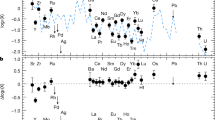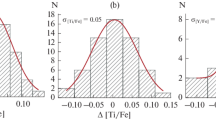Abstract
On the theory that peculiar A stars were once secondaries in binary systems in which the primaries exploded as type II supernovae, the nucleosynthesis during the final stages of evolution of massive stars is investigated. For heavy elements (Z>30) the observed abundances in peculiar. A stars reflect the composition of material ejected by the exploding primaries. Peculiar A stars are divided into two groups, the main group and the Mn group, and abundances in each group are summarised. During the explosions of the primaries, rapid (n, γ) or (γ, n) reactions operate on the abundance peaks previously formed by the s-process during the giant phase. In the main group primaries (n, γ) reactions predominate, and rare-earths are formed from the Ba peak. In the Mn group primaries (γ, n) reactions operate on the Sr, Ba and Pb peaks to form Kr, Xe and Hg.
Similar content being viewed by others
References
Aller, L. H. andRoss, J. E.: 1967, inThe Magnetic and Related Stars (ed. by R. C. Cameron), Mono Book Corporation, Baltimore, p. 339.
Bahcall, J. N.: 1962,Phys. Rev. 126, 1143.
Bashkin, S.: 1965, inStars and Stellar Systems, Vol. 8 (ed. by L. H. Aller and D. B. McLaughlin), Univ. of Chicago Press, Chicago, p. 1.
Bidelman, W. P.: 1962,Sky and Telescope 23, 140.
Bidelman, W. P.: 1966, inAbundance Determinations in Stellar Spectra (ed. by H. Hubenet), Academic Press, New York and London, p. 229.
Burbidge, E. M., Burbidge, G. R., Fowler, W. A., andHoyle, F.: 1957,Rev. Mod. Phys. 29, 547.
Burbidge, G. R.: 1962, inStar Evolution (ed. by L. Gratton)., Academic Press, New York and London, p. 95.
Burbidge, G. R., andBurbidge, E. M.: 1955,Astrophys. J. Suppl. Ser. 1, 431.
Clayton, D. D. andRassbach, M. E.: 1967,Astrophys. J. 148, 69.
Corliss, C. H. andBozman, W. R.: 1962, National Bureau of Standards Monograph, No. 53.
Guthrie, B. N. G.: 1966,Publ. Roy. Obs. Edinburgh 5, 181.
Guthrie, B. N. G.: 1967,Publ. Roy. Obs. Edinburgh 6, 1.
Guthrie, B. N. G.: 1968,Publ. Roy. Obs. Edinburgh 6, 145.
Hayward, E.: 1963,Rev. Mod. Phys. 35, 324.
Hiyle, F. andFowler, W. A.: 1960,Astrophys. J. 132, 565.
Jaschek, M. andGarcia, Z. L.: 1966,Z. Astrophys. 64, 217.
Jugaku, J. andSargent, W. L. W.: 1968,Astrophys. J. 151, 259.
Macklin, R. L. andGibbons, J. H.: 1965,Rev. Mod. Phys. 37, 166.
Meggers, W. F.: 1941,J. Opt. Soc. Am. 31, 39 and 605.
Seeger, P. A., Fowler, W. A., andClayton, D. D.: 1965,Astrophys. J. Suppl. Ser. 11, 121.
Truran, J. W., Arnett, W. D., Tsuruta, S., andCameron, A. G. W.: 1968,Astrophys. Space Sci. 1, 129.
Van den Heuvel, E. P. J.: 1967,Bull. Astron. Inst. Neth. 19, 11.
Zaidel, A. N., Prokofev V. K., andRaiskii, S. M.: 1961,Tables of Spectrum Lines, Pergamon Press, London.
Author information
Authors and Affiliations
Rights and permissions
About this article
Cite this article
Guthrie, B.N.G. Heavy-element abundances in peculiar a stars. Astrophys Space Sci 3, 542–551 (1969). https://doi.org/10.1007/BF00704859
Received:
Issue Date:
DOI: https://doi.org/10.1007/BF00704859




